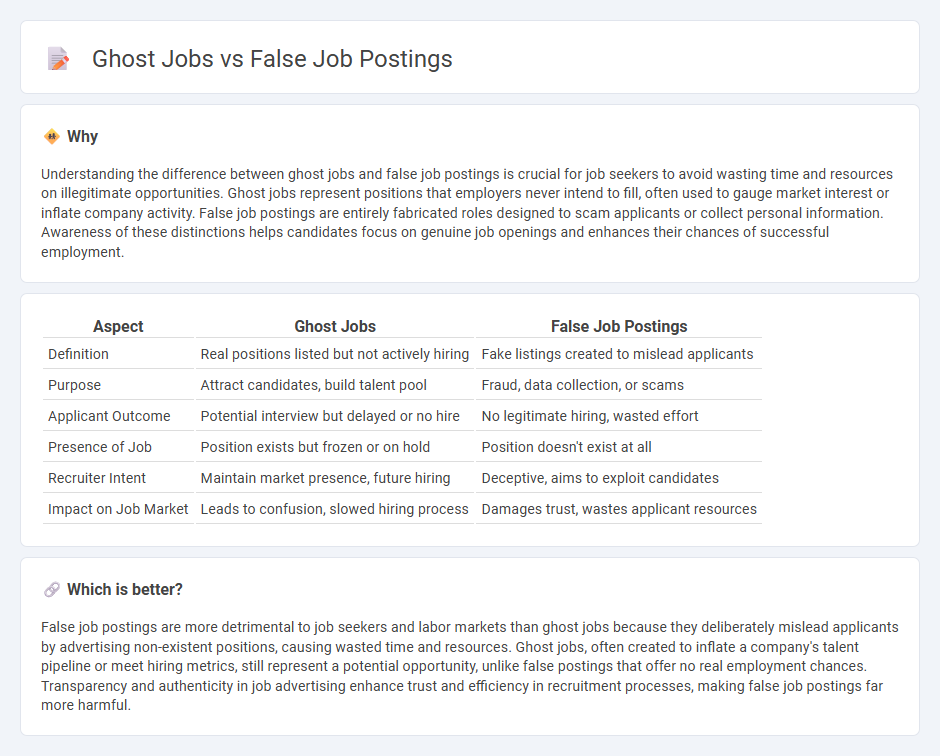
Ghost jobs refer to job openings that companies advertise but have no genuine intent to fill, often used to build candidate databases or gauge market interest. False job postings involve deceptive listings that mislead applicants about job roles, qualifications, or benefits, sometimes used to attract applicants for unrelated purposes. Discover the key differences and implications of these practices in the employment landscape.
Why it is important
Understanding the difference between ghost jobs and false job postings is crucial for job seekers to avoid wasting time and resources on illegitimate opportunities. Ghost jobs represent positions that employers never intend to fill, often used to gauge market interest or inflate company activity. False job postings are entirely fabricated roles designed to scam applicants or collect personal information. Awareness of these distinctions helps candidates focus on genuine job openings and enhances their chances of successful employment.
Comparison Table
| Aspect | Ghost Jobs | False Job Postings |
|---|---|---|
| Definition | Real positions listed but not actively hiring | Fake listings created to mislead applicants |
| Purpose | Attract candidates, build talent pool | Fraud, data collection, or scams |
| Applicant Outcome | Potential interview but delayed or no hire | No legitimate hiring, wasted effort |
| Presence of Job | Position exists but frozen or on hold | Position doesn't exist at all |
| Recruiter Intent | Maintain market presence, future hiring | Deceptive, aims to exploit candidates |
| Impact on Job Market | Leads to confusion, slowed hiring process | Damages trust, wastes applicant resources |
Which is better?
False job postings are more detrimental to job seekers and labor markets than ghost jobs because they deliberately mislead applicants by advertising non-existent positions, causing wasted time and resources. Ghost jobs, often created to inflate a company's talent pipeline or meet hiring metrics, still represent a potential opportunity, unlike false postings that offer no real employment chances. Transparency and authenticity in job advertising enhance trust and efficiency in recruitment processes, making false job postings far more harmful.
Connection
Ghost jobs and false job postings both mislead job seekers by presenting non-existent or falsely advertised opportunities, creating inefficiencies in the employment market. Employers may use ghost jobs to inflate headcount or attract talent pools without intent to hire immediately, while false job postings can serve to gather applicant data or test candidate interest. This deceptive practice undermines trust in online job platforms, prolongs job searches, and wastes valuable resources for both candidates and recruiters.
Key Terms
Recruitment Fraud
False job postings involve fraudulent advertisements designed to collect personal information or payment without any intention of hiring, while ghost jobs are legitimate listings kept active to build candidate pools without immediate vacancies. Recruitment fraud predominantly exploits false job postings by misleading applicants, causing financial loss and identity theft. Explore detailed insights into identifying and protecting yourself from recruitment fraud to stay safe in the job market.
Phantom Listings
Phantom listings represent deceptive job postings that remain open without genuine intent to hire, often used to attract resumes or assess market trends. Unlike false job postings that may contain incorrect details, phantom listings are entirely non-existent roles designed to mislead job seekers and inflate the employer's brand presence. Explore more to understand how phantom listings impact job market transparency and candidate experience.
Applicant Tracking
False job postings often mislead applicants by advertising positions that do not exist, while ghost jobs are legitimate openings that remain unfilled or unpublished internally despite being listed externally. Applicant Tracking Systems (ATS) play a critical role in filtering and managing these listings, helping employers distinguish genuine vacancies from deceptive or outdated postings. Explore how advanced ATS technology enhances recruitment accuracy and applicant experience.
Source and External Links
How to Spot a Fake Job Posting | Acara Solutions - Fake job postings often have warning signs like unusually high salaries for little experience, vague job descriptions, no company information, and unprofessional communication, with scams tripling from 2020 to 2024 causing massive financial losses for job seekers.
How To Identify Fake Job Postings: 10 Warning Signs | Indeed.com - Key signs of fake job postings include unsolicited recruiter contact, immediate job offers without interviews, requests for unusual personal information, and other red flags designed to steal personal details from job seekers.
The Fake Job Epidemic Designed To Waste Your Time - YouTube - Many companies post fake or "ghost" jobs which waste applicants' time and money but can benefit the companies by boosting revenues and employee morale, contributing to difficulty in finding real work despite numerous listings.
 dowidth.com
dowidth.com